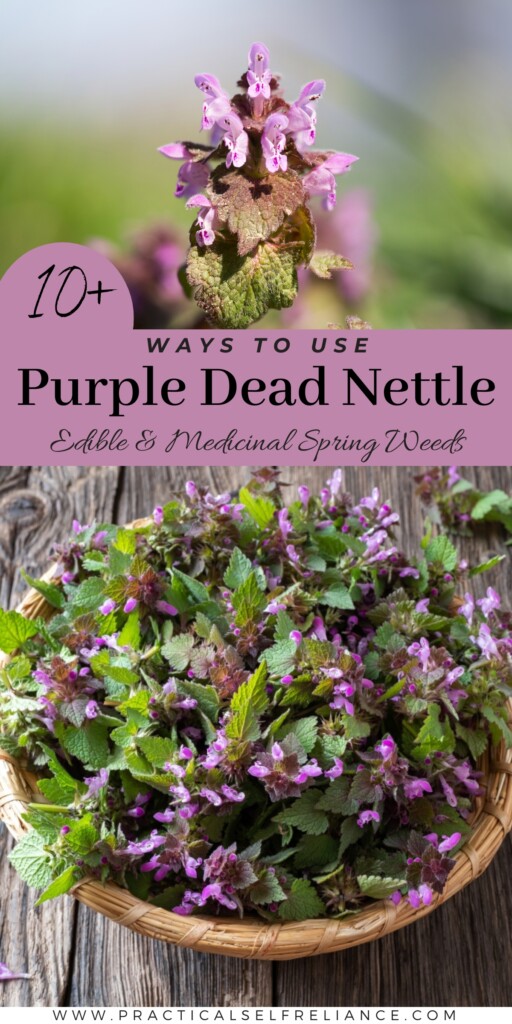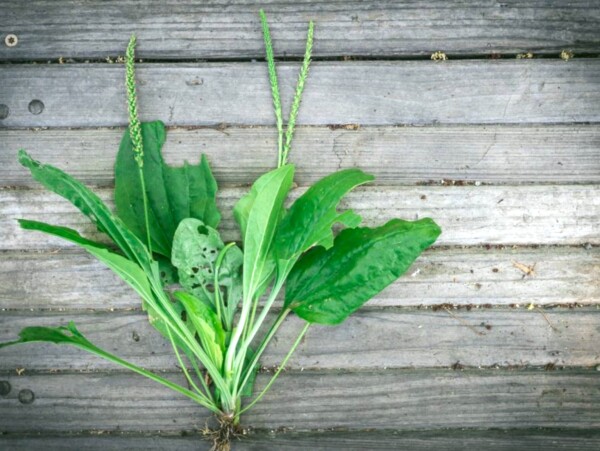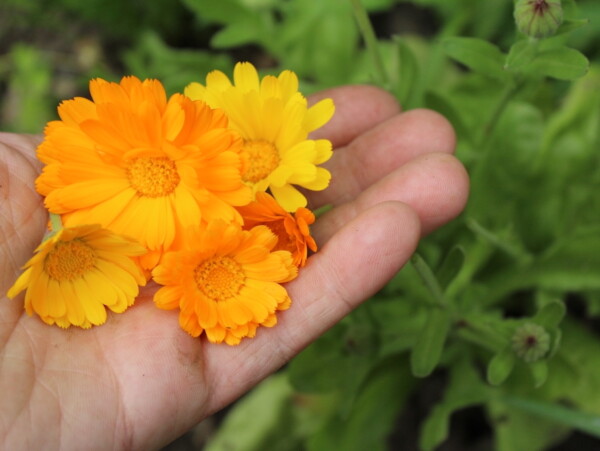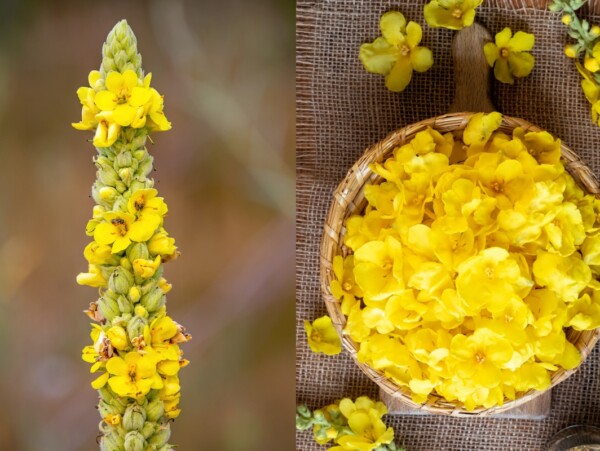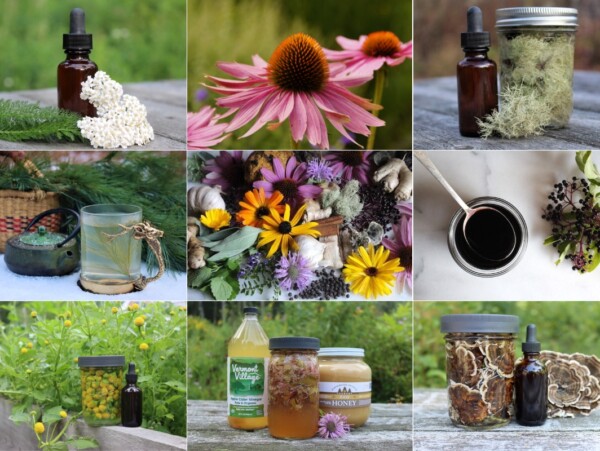Affiliate disclosure: This post may contain affiliate links. Please see our Privacy Policy.
Purple dead nettle is one of the first wild plants to pop up in early spring, and it’s a lot more useful than it looks. This fuzzy, purple-topped “weed” is edible, medicinal, and loved by pollinators—plus, it’s easy to identify and abundant in lawns and garden beds. Whether you’re foraging for wild greens or stocking your herbal medicine cabinet, it’s a great plant to know.
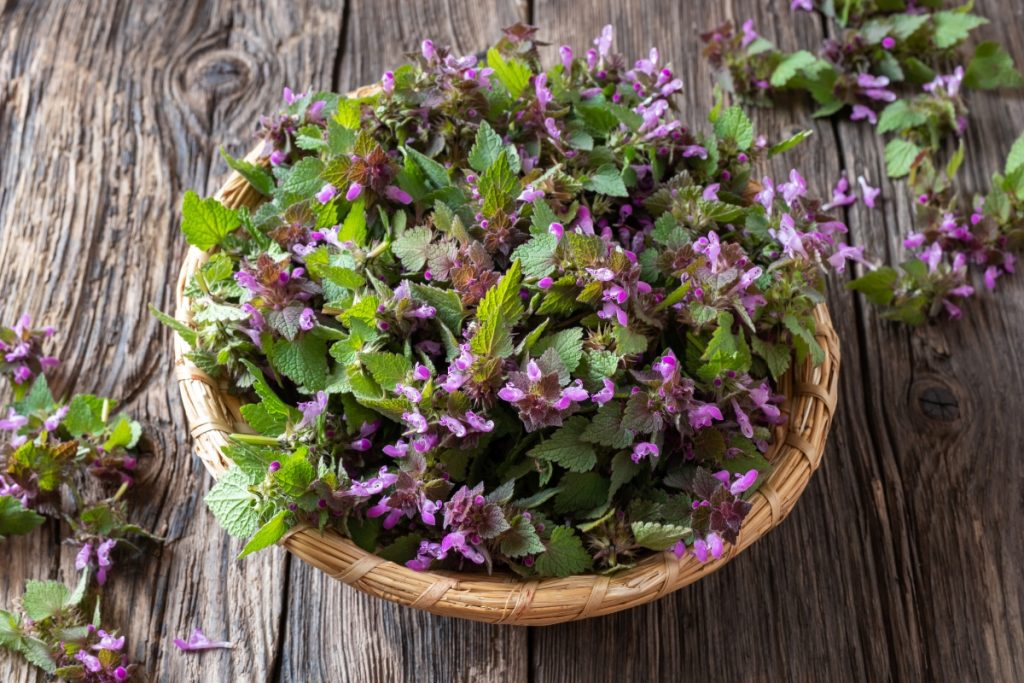
Table of Contents
- Identifying Purple Dead Nettle
- Harvesting Purple Dead Nettle
- Ways to Use Purple Dead Nettle
- Purple Dead Nettle as a Spring Green
- Purple Dead Nettle Herbal Tea
- Making a Purple Dead Nettle Tincture
- Infused Oil for Skin Care
- Purple Dead Nettle Salve
- Natural Poultice for Bug Bites and Scrapes
- Early Spring Allergy Support
- Pesto and Smoothies
- Compost Booster and Soil Cover
- Feed the Pollinators
- Ecological Benefits
Purple dead nettle (Lamium purpureum) might look like just another backyard weed, but don’t be too quick to pull it. This fuzzy little plant with purple tops shows up early in the spring—often before anything else is growing—and it’s packed with more value than you’d expect. It’s edible, medicinal, and a favorite among foragers once you get to know it.
Despite the name, purple dead nettle won’t sting you (it’s part of the mint family, not the stinging nettle crew), and it’s easy to identify. With its square stems, soft leaves that blush purple at the top, and tiny hooded flowers, it’s one of the first signs that foraging season is finally here. Whether you’re looking for early greens, natural remedies, or just a way to feed the bees, purple dead nettle is worth a second look.

Identifying Purple Dead Nettle
Purple dead nettle is a winter annual that thrives in USDA zones 4 through 9. It typically germinates in the fall, overwinters as a seedling, and blooms in early spring. The cycle repeats year after year.
Identifying Purple Dead Nettle is easy enough, the plant features square stems—a characteristic of the mint family—and leaves that are heart- or triangular-shaped with a purplish hue at the top, fading to green as they mature. Its small, tubular flowers are bright red-purple and bloom from mid- to late spring.
Purple dead nettle is commonly found in meadows, forest edges, roadsides, and gardens, especially in disturbed soils. It often grows in large patches, making it easy to forage.
It’s one of many weeds with purple flowers, but still, it’s easy enough to separate from the rest.
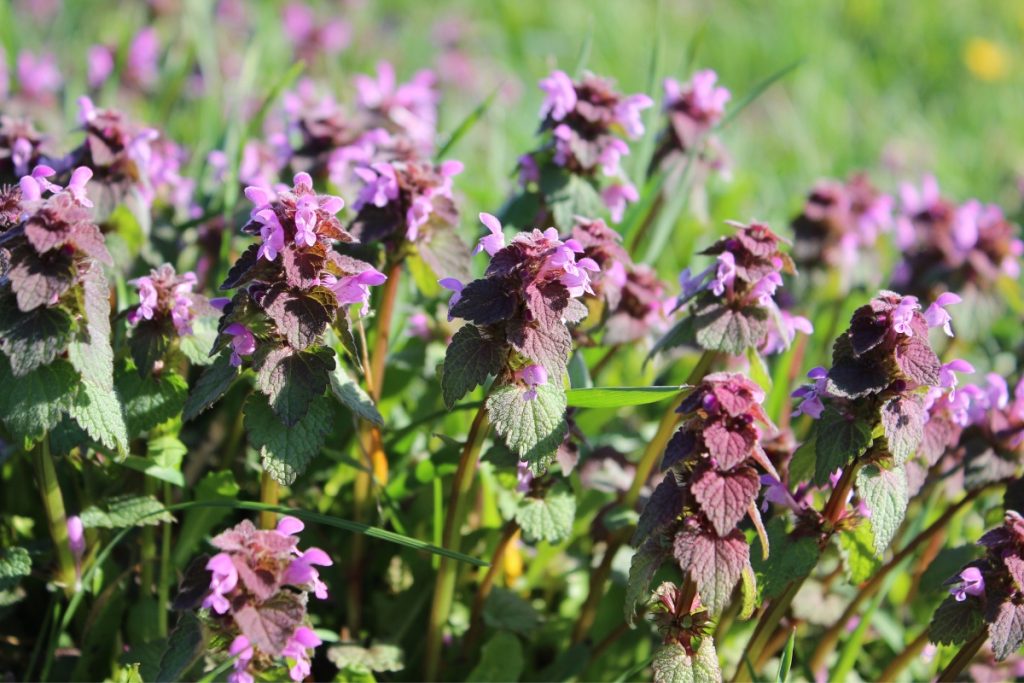
Harvesting Purple Dead Nettle
The best time to harvest purple dead nettle is in early spring when the plant is young and tender. To harvest, snip the stems about half an inch from the ground and gently shake to remove any dirt or insects. It’s advisable to harvest from areas that are free from pesticides and pollutants.
After harvesting, rinse the plant material thoroughly and allow it to dry completely if you plan to store it. Dried purple dead nettle can be stored in an airtight container for up to a year.
Medicinal Uses of Purple Dead Nettle
Purple dead nettle has been traditionally used for its medicinal properties, which include:
- Anti-inflammatory: Helps reduce inflammation and soothe irritated tissues.
- Antibacterial and Antifungal: Assists in preventing infections when applied topically.
- Astringent: Can help tighten and tone tissues, making it useful for minor wounds.
- Diuretic: Promotes the elimination of excess fluids from the body.
- Allergy Relief: Some herbalists use it to alleviate seasonal allergies.
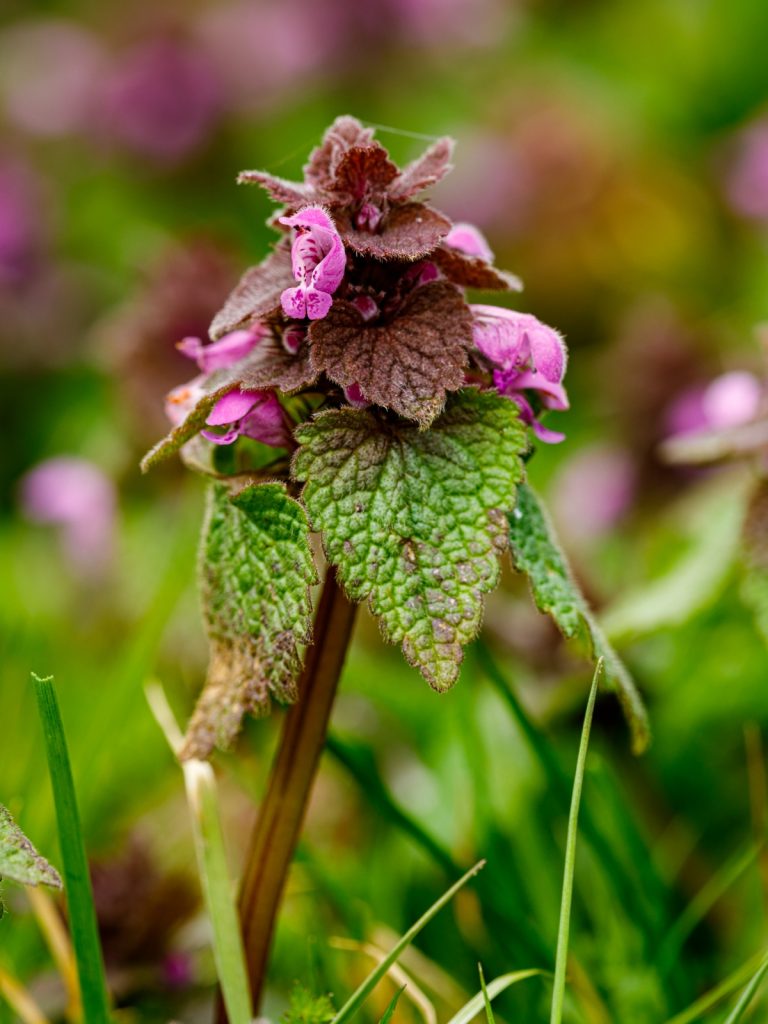
Ways to Use Purple Dead Nettle
Purple dead nettle has a long history of use in folk medicine and wild foods, and it’s one of the easiest spring herbs to work with. The leaves, stems, and flowers are all edible and can be used fresh or dried in a wide variety of preparations.
Whether you’re looking to make a quick tea or a skin-soothing salve, this little plant is surprisingly versatile. Here are some of the most practical and effective ways to put purple dead nettle to use.
Purple Dead Nettle as a Spring Green
Purple dead nettle is edible and surprisingly nutritious, especially when young and tender. The leaves can be eaten raw or cooked, and they’re loaded with antioxidants, iron, vitamin C, and fiber. When eaten fresh, the flavor is mild and earthy, making it an easy addition to everyday meals.
You can toss young leaves into fresh salads or mix them into scrambled eggs, much like spinach or kale. For larger harvests, the leaves can be sautéed, wilted into soups, or blended into sauces and pestos. If raw greens aren’t your thing, try drying the leaves and adding them to herbal tea blends or green powder mixes.
Purple Dead Nettle Herbal Tea
One of the simplest ways to enjoy purple dead nettle is as a calming herbal tea. Just steep the fresh or dried leaves in hot water for 10 to 15 minutes. The flavor is gentle—somewhere between green tea and mint—and it pairs nicely with lemon balm, chamomile, or a spoonful of honey.
Purple dead nettle tea has traditionally been used to support the immune system and relieve minor seasonal allergies. It’s mildly astringent and has natural anti-inflammatory compounds, which can help soothe a scratchy throat or ease early allergy symptoms in spring. If you’re harvesting it fresh, try drying a batch to enjoy year-round.
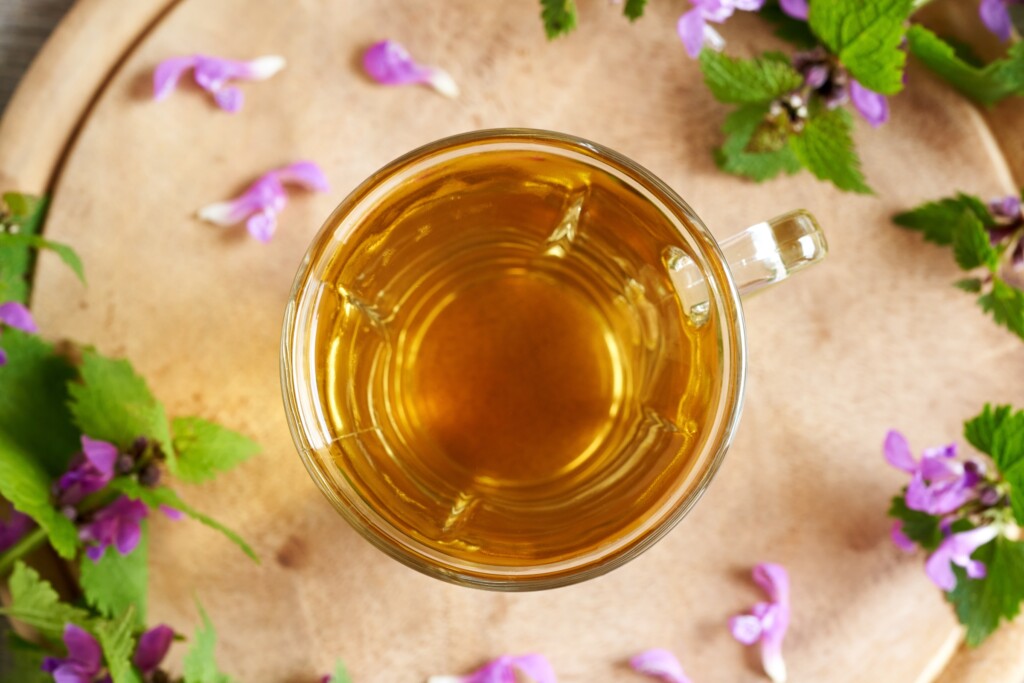
Making a Purple Dead Nettle Tincture
Tinctures are one of the most shelf-stable ways to preserve wild herbs, and purple dead nettle is no exception. It makes a useful tincture that supports the immune system and may help relieve seasonal allergy symptoms, particularly in early spring.
To make a purple dead nettle tincture, pack fresh purple dead nettle into a clean jar and cover it with high-proof alcohol like vodka. Let it steep for about four to six weeks, shaking occasionally. Once strained, the tincture will keep for several years in a dark cabinet. It’s generally taken in small doses (like ½ to 1 tsp) during allergy season or added to a cup of water or tea.
Infused Oil for Skin Care
Purple dead nettle has soothing properties that make it useful for skin conditions like minor rashes, bug bites, or dry patches. One of the best ways to use it topically is as an infused oil. This simple preparation captures the herb’s properties in a gentle, skin-safe form.
To make an infused oil, dry the leaves completely (to prevent spoilage), then steep them in a neutral oil like olive oil or sweet almond oil for a few weeks. The result is a light green herbal oil that can be used on its own or turned into salves and balms. Keep it on hand for everyday skin care, or blend it with calendula or plantain for added healing power.
Purple Dead Nettle Salve
Once you’ve made an infused oil, turning it into a salve is the next step—and it’s easier than you might think. A basic salve is simply herb-infused oil mixed with beeswax, and optionally a few drops of essential oil like lavender or tea tree.
This soothing balm is ideal for treating dry skin, minor cuts, chapped lips, or even diaper rash. The anti-inflammatory and antimicrobial properties of purple dead nettle make it a surprisingly useful first-aid salve for spring and summer.
Purple dead nettle salve can be kept in your herbal cabinet, and it’s just as useful tossed into your hiking bag.
Natural Poultice for Bug Bites and Scrapes
If you’re out in the garden or woods and end up with a bug bite or scratch, purple dead nettle can be a quick herbal fix. Simply crush a few fresh leaves between your fingers or mash them with a bit of water to create a paste.
Apply the paste directly to the affected area, then wrap with gauze or a clean cloth. The natural anti-inflammatory compounds help soothe itching and redness, while its antimicrobial properties may help prevent infection. It’s not a long-term treatment, but it’s great in a pinch when you’re working outdoors or foraging in the wild.
Early Spring Allergy Support
Purple dead nettle emerges just when allergy season begins, which is part of why it’s traditionally been used to soothe hay fever and sinus issues. Though clinical studies are limited, many herbalists include it in formulas for easing seasonal allergy symptoms like congestion and sneezing.
This is likely due to its mild astringent and anti-inflammatory effects, along with the presence of antioxidants. It’s often used in combination with herbs like nettle (Urtica dioica), goldenrod, and elderflower. Whether taken as a tea or tincture, it’s worth adding to your spring wellness kit.
Pesto and Smoothies
One of the easiest (and tastiest) ways to use purple dead nettle is in the kitchen. It makes a fantastic wild substitute for spinach, especially in early spring before garden greens are producing. One popular preparation is purple dead nettle pesto.
Blend the leaves with olive oil, garlic, nuts, and parmesan cheese, just like you would with basil. It’s delicious tossed with pasta, spread on bread, or swirled into soups. If you’re more of a smoothie drinker, toss a handful of fresh leaves into your blender with fruit and greens for a subtle earthy flavor and extra nutrition.
Compost Booster and Soil Cover
If you find yourself with a bumper crop of purple dead nettle, don’t toss it in the trash—use it in your compost pile. It’s rich in nitrogen and breaks down quickly, making it a great “green” material for balancing out carbon-heavy compost ingredients like leaves or straw.
Beyond composting, purple dead nettle serves as a natural living mulch. Since it grows thickly in early spring, it helps protect bare soil from erosion and can even suppress early weed growth. Just be sure to pull it before it goes to seed if you don’t want it taking over your garden beds.
Feed the Pollinators
One of purple dead nettle’s most overlooked benefits is how valuable it is to pollinators. It blooms in early spring when few other flowers are available, offering nectar and pollen to bees, butterflies, and other beneficial insects.
If you’re not planning to harvest every last patch, consider leaving some for the pollinators. This plant plays a critical role in supporting early foraging bees—and the longer it flowers, the more helpful it is to your local ecosystem. Even if you forage some, there’s usually more than enough to go around.
Ecological Benefits
Beyond its uses for humans, purple dead nettle plays a vital role in the ecosystem:
- Pollinator Support: Its early spring blooms provide nectar and pollen for bees and other pollinators when few other plants are flowering.
- Soil Health: As a ground cover, it helps prevent soil erosion and can improve soil fertility over time.
- Biodiversity: By supporting pollinators and other insects, it contributes to greater biodiversity in gardens and wild areas.
Purple dead nettle might look like just another weed, but it’s actually one of the handiest plants you’ll find popping up in early spring. Between its herbal uses, edible leaves, and love from the bees, it definitely earns a spot in your foraging basket. So next time you see those fuzzy purple tops, don’t just walk past—bring a few home for your kitchen or medicine cabinet.
